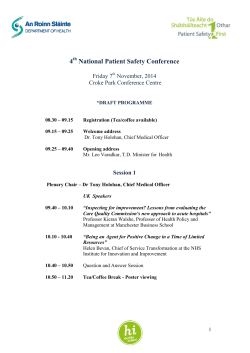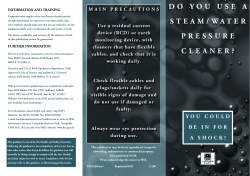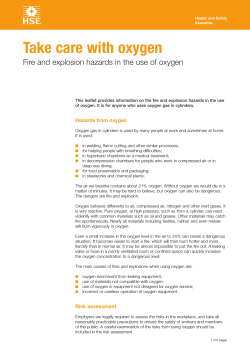
Young people and work experience
Health and Safety Executive Young people and work experience A brief guide to health and safety for employers Introducing young people to the world of work can help them understand the work environment, choose future careers or prepare for employment. An appreciation of workplace risk and how to deal with it can be one of the biggest benefits offered by a work placement. Introduction This is a web-friendly version of leaflet INDG364(rev1), published 06/13 This leaflet is aimed at employers who provide work experience opportunities to young people. It will help you, and those responsible for work experience in your business, ensure young people have their health and safety protected while they are with you. Under health and safety law, work experience students are your employees. You treat them no differently to other young people you employ. You may have considerable experience of successfully employing young people or taking on work experience students. If not, there are just a few steps that you need to take. Schools and colleges, or others organising placements, need to check that you have risk management arrangements in place. Conversations you have with the placement organiser could simply be noted for reference. Taking on work experience students should be straightforward. It should not be about generating unnecessary paperwork. This guidance describes how to keep it simple. Definitions of young people and children by age ■■ A young person is anyone under 18. ■■ A child is anyone who has not yet reached the official minimum school leaving age (MSLA). Pupils will reach the MSLA in the school year in which they turn 16. Page 1 of 6 Health and Safety Executive What you need to do Simply use your existing arrangements for assessing and managing risks to young people. Avoid repeating your assessment of the risks if a new student is of a broadly similar level of maturity and understanding, and has no particular or additional needs (the organiser or parent should tell you if they have). If you don’t currently employ a young person, have not done so in the last few years and are taking on a work experience student for the first time, or one with particular needs, review your risk assessment before they start. Discuss the placement in advance with organisers. Take account of what they and the parents or carers tell you of the student’s physical and psychological capacity and of any particular needs, for example due to any health conditions or learning difficulties. Keep any additional work in proportion to the environment: ■■ For placements in low-risk environments, such as offices or shops, with ■■ ■■ everyday risks that will mostly be familiar to the student, your existing arrangements for other employees should be enough. For environments with risks less familiar to the student (eg in light assembly or packing facilities), you will need to make arrangements to manage the risks – this will include induction, supervision, site familiarisation, and any protective equipment needed. For a placement in a higher-risk environment, such as construction, agriculture and manufacturing, you will need to: ▬▬ consider what work the student will be doing or observing, the risks involved in that work and how these are managed; ▬▬ satisfy yourself that the instruction, training and supervisory arrangements have been properly thought through and that they work in practice. You may, particularly for higher-risk environments, need to consider specific factors that must be managed for young people, including exposure to radiation, noise and vibration, toxic substances, or extreme temperatures. Where these specific factors exist in your workplace you should already have control measures in place. This will also apply to legally required age limits on the use of some equipment and machinery (eg forklift trucks and some woodworking machinery). Consider whether you need to do anything further to control the risks to young people. Explain to parents/carers of children what the significant risks are and what has been done to control them. This can be done in whatever way is simplest and suitable, including verbally, and is very often done through the school or college. When you induct students, explain the risks and how they are controlled, checking that they understand what they have been told. Check that students know how to raise any health and safety concerns. Young people and work experience Page 2 of 6 Health and Safety Executive Training and supervision Many young people are likely to be new to the workplace and in some cases will be facing unfamiliar risks, from the job they will be doing and from their surroundings. You will need to provide them with clear and sufficient instruction, training and supervision to enable them to work without putting themselves and other people at risk. Young people are likely to need more supervision than adults. Good supervision will help you get a clear idea of the young person’s capabilities and progress in the job and monitor the effectiveness of their training. You will need to consider how much training is necessary. A proportionate approach is needed, for example a low-risk business would not be expected to have a need for lengthy technical training. Similarly, where a student is on a shortterm work experience placement, induction and training needs should be tailored to the tasks they are going to be doing. It is important that you check young people have understood the instruction and training which will include, for example: ■■ the hazards and risks in the workplace; ■■ the health and safety precautions that are in place. In workplaces where there are health and safety representatives, they can play a valuable role early on by: ■■ introducing the young person to the workplace; ■■ helping with their ongoing training; ■■ giving you feedback about particular concerns. As employees, young people have a duty to take care of their own health and safety and that of others who may be affected by their actions. This includes co-operating with you by listening carefully, following instructions, using any safety equipment that you have provided and taking part in relevant training. What the law says Under health and safety law, every employer must ensure, so far as reasonably practicable, the health and safety of all their employees, irrespective of age. As part of this, there are certain considerations that need to be made for young people. This section outlines the requirements in the law. Putting the requirements into practice should be straightforward and in most cases you should already have the necessary risk management arrangements in place. What does ‘so far as reasonably practicable’ mean? This means balancing the level of risk against the measures needed to control the real risk in terms of money, time or trouble. However, you do not need to take action if it would be grossly disproportionate to the level of risk. Young people and work experience Page 3 of 6 Health and Safety Executive Under the Management of Health and Safety at Work Regulations 1999, you have a responsibility to ensure that young people employed by you are not exposed to risk due to: ■■ lack of experience; ■■ being unaware of existing or potential risks; ■■ lack of maturity. You must consider: ■■ ■■ ■■ ■■ ■■ ■■ the layout of the workplace; the physical, biological and chemical agents they will be exposed to; how they will handle work equipment; how the work and processes are organised; the extent of health and safety training needed; risks from particular agents, processes and work. These considerations should be straightforward in a low-risk workplace, for example an office. In higher-risk workplaces the risks are likely to be greater and will need more attention to ensure they’re properly controlled. HSE’s frequently asked questions (FAQs) web page on young people at work provides further advice on making the necessary considerations (www.hse.gov.uk/ youngpeople/faqs.htm). You need to consider whether the work the young person will do: ■■ is beyond their physical or psychological capacity: ▬▬ this doesn’t have to be complicated, it could be as simple as checking a ■■ ■■ ■■ ■■ young person is capable of safely lifting weights and of remembering and following instructions; involves harmful exposure to substances that are toxic, can cause cancer, can damage or harm an unborn child, or can chronically affect human health in any other way: ▬▬ be aware of substances a young person might come into contact with in their work, consider exposure levels and ensure legal limits are met; involves harmful exposure to radiation: ▬▬ ensure a young person’s exposure to radiation is restricted and does not exceed the allowed dose limit; involves risk of accidents that cannot reasonably be recognised or avoided by young people due to their insufficient attention to safety or lack of experience or training: ▬▬ a young person might be unfamiliar with ‘obvious’ risks. An employer should consider the need for tailored training/closer supervision. has a risk to health from extreme cold, heat, noise or vibration: ▬▬ in most cases, young people will not be at any greater risk than adults and for workplaces that include these hazards it is likely there will already be control measures in place. A child must never carry out such work involving these risks, whether they are permanently employed or under training such as work experience. Young people and work experience Page 4 of 6 Health and Safety Executive A young person, who is not a child, can carry out work involving these risks if: ■■ the work is necessary for their training; ■■ the work is properly supervised by a competent person; ■■ the risks are reduced to the lowest level, so far as reasonably practicable (see the explanation on page 3). Providing supervision for young workers and monitoring their progress will help you identify where additional adjustments may be needed. You must let the parents or guardians of any child know the possible risks and the measures put in place to control them. This can be done in whatever way is simplest and suitable, including verbally. You will already be familiar with the risks associated with your workplace and should be in a position to consider what is or is not appropriate. Other issues you need to consider There are other agents, processes and work that should be taken into account when employing a young person. The following list doesn’t cover all of those, but if any of the issues are relevant to your workplace you can find more information on HSE’s website (see ‘Find out more’ for web links): ■■ ■■ ■■ ■■ ■■ ■■ ■■ ■■ ■■ ■■ biological agents; working with chemicals; working with lead and lead processes; asbestos; working with explosives, including fireworks; working with compressed air; construction, including demolition; electrical safety; agriculture; manufacturing. Working hours and young workers Working hours are not governed by health and safety law. Young people and children have different employment rights from adult workers and are subject to protections in relation to the hours they can work. Other regulations Children below the minimum school leaving age (MSLA) must not be employed in industrial workplaces such as factories, construction sites etc, except when on work experience. Children under 13 are generally prohibited from any form of employment. Local authorities have powers to make bye-laws on the types of work, and hours of work, children aged between 13 and the MSLA can do. Young people and work experience Page 5 of 6 Health and Safety Executive Find out more For more information about health and safety and young people, visit our young people web pages: www.hse.gov.uk/youngpeople/ Health and safety made simple: The basics for your business Leaflet INDG449 HSE Books 2011 www.hse.gov.uk/pubns/INDG449.htm Microsite: www.hse.gov.uk/simple-health-safety/manage.htm The health and safety toolbox: How to control risks at work provides helpful areas of advice, which apply to all workplaces: www.hse.gov.uk/toolbox/ Further guidance to help you protect new starters: www.hse.gov.uk/ vulnerable-workers/new-to-the-job.htm More information on working hours for young workers: www.gov.uk/child-employment/minimum-ages-children-can-work Helpful links for other issues you may need to consider ■■ ■■ ■■ ■■ ■■ ■■ ■■ ■■ ■■ ■■ Biological agents: www.hse.gov.uk/biosafety/ Working with chemicals: www.hse.gov.uk/chemicals/ Working with lead and lead processes: www.hse.gov.uk/lead/ Asbestos: www.hse.gov.uk/asbestos Working with explosives, including fireworks: www.hse.gov.uk/explosives/ Working with compressed air: www.hse.gov.uk/compressedair/ Construction, including demolition: www.hse.gov.uk/construction/safetytopics/ stability.htm Electrical safety: www.hse.gov.uk/electricity/ Agriculture: www.hse.gov.uk/agriculture/ Manufacturing: www.hse.gov.uk/manufacturing/ Further information For information about health and safety, or to report inconsistencies or inaccuracies in this guidance, visit www.hse.gov.uk/. You can view HSE guidance online and order priced publications from the website. HSE priced publications are also available from bookshops. This guidance is issued by the Health and Safety Executive. Following the guidance is not compulsory, unless specifically stated, and you are free to take other action. But if you do follow the guidance you will normally be doing enough to comply with the law. Health and safety inspectors seek to secure compliance with the law and may refer to this guidance. This leaflet is available at www.hse.gov.uk/pubns/indg364.htm. © Crown copyright If you wish to reuse this information visit www.hse.gov.uk/copyright.htm for details. First published 06/13. Published by the Health and Safety Executive 06/13 INDG364(rev1) Page 6 of 6
© Copyright 2025





















